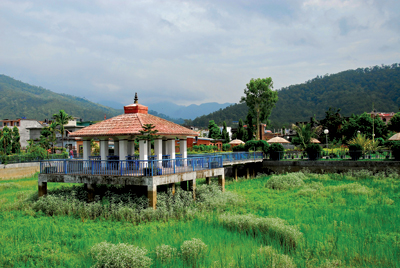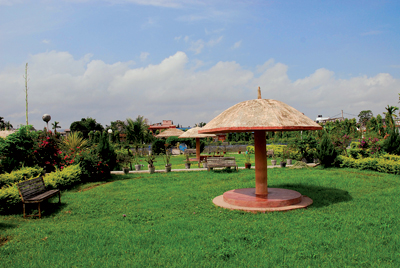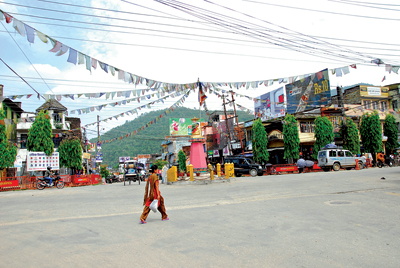The industrial town of Hetauda in Nepal's southern plains has its share of interesting trivia.
The Tarai will always hold a special place in my heart, a land where life is worked out of the earth, with warmth, reflecting those bright, special hues of morning and evening time, contrasting life in this old jungle area. There are many reasons not to go Tarai-side, such as: mosquitoes, slow tourism development and far too many languages to ever be understood. Yet it provides a place where adventures and simple luxuries can be found.
 Next time you have to go to Birgunj or the border crossing of Raxal, in Bara District, maybe you too would consider a different route, and stop at the small hill-station of Hetauda, for a little time outside of the norm’.
Next time you have to go to Birgunj or the border crossing of Raxal, in Bara District, maybe you too would consider a different route, and stop at the small hill-station of Hetauda, for a little time outside of the norm’.
Why?
Hetauda, the district capital for Makwanpur, is by far one of the quaintest, most well thought-out towns along the Tarai, thanks to its first Mir, or town chief. He laid out the major road-junctions, making it the central point it is, outside of the town. The roads to Chitwan, India and Kathmandu, don’t come near the town-centre. Trees line the streets, shop and market placement makes sense and the whole place gives an air of calm, tranquil organization.
Three rivers: the Rapti, Kara and Bagi cut Hetauda in three lines, turning it into a triangular island, giving the place a unique character. All this water also aids in making the flaura and fauna of this jungle area quiet diverse. Flowers such as orchids grow in abundance in this environment, as does medicinal herbs or Jheribhuti. Just outside of town is another island, cut by two rivers, here is a centre for studying and learning all about the aforementioned jheributhi. These rivers also provide pleasant respite on those hot Tarai-day’s.
 Feminine Powers
Feminine Powers
Hetauda, takes its name after a fearsome, demonic queen that lived in its malaria-infested jungles, long ago. Her name was Hedumba and all of the area around the town is considered a Devi place: affected by the world’s feminine energies. Hedumba ended up marrying one of the Pandav princes’, who fled after the Mahabharat wars. Bhimphedi, high up the top hill over Hetauda, was the name of the old district capital, named after the prince, Bhimsen. Also, it is said, that the now infamous Indian-yogi, Pilot Baba, who is known for burying himself alive for weeks on end, even in water, started his Sadhu-life here. He is well known too, for his ability to heal, perhaps a reflection of his time in this area.
The jungle surrounding Hetauda, stretches up the Sivalik Hills (a fortress of rock that kept marauding armies at bay through centuries) and all the way over to Chitwan National Park. In past days, wandering rhinos were a common sight at the local market. Those times have changed, but still a diversity of wildlife can be spotted, including the adorable, white haired monkey.
The area’s diverse forestry is also the reason why one of Nepal’s two Institutes of Forestry is located here. Teaching the next generating of Park Rangers and Forestry workers.
 The First!
The First!
The Tribhuvan Highway, which cuts through Hetauda, has the distinction of being Nepal’s first road, connecting it to the outside world. Finished in 1956, with the assistance of India, it took the name of King Tribhuvan, who died the year before. It also was the site of Nepal’s first motoring tunnel, just big enough for one jeep, although no longer in use, it is possible to find outside the town on the Birgunj-side, near Churiyamai Temple. The highway has undergone massive development in recent years and now is almost totally “black-topped”, making the journey to Kathmandu, of 158Km, possible by jeep, in under four hours. Other ongoing developments will see the journey cut to 108Km, in the near future.
The 1960s saw the start of the eradication of malaria in the Tarai’s jungles and many peoples of Nepal and India came to settle here after. It is why you can find just about every one of Nepal’s intricate social-fabric living here, side by side. The Tribhuvan Highway, is also the reason why Hetauda has become a major industrial zone, with many factories producing items such as steel, but thanks to smart planning, it is all kept far-out, from the town.
When foreign INGOs started working in Nepal, Hetauda was one of the very first locations, back in the 70s. It may have something to do with the planning and upkeep that can be seen around the town. There are also a number of well laid out parks to visit, to while away the evenings. Pushpa Lal Ukari Park, for example, has a small lake, with a seating area in the centre, the layout is very clean and is home to many types of flowers and medicinal herbs, but in an educative way, with labels in various languages, teaching people their importance.
 Out And About
Out And About
If wondering what else to do here, why not visit the local cinema, screening Nepali movies at three o’clock each day and a Hindi movie in the evenings. Or, you could have an exploration at the numerous Indian eateries, where you can get many types of super-sweet meethi-sweets, or thali, the Indian version of the ubiquitous dal-bhat.
For accommodation there are a few simple places to stay near the bus-station, or, if feeling financially flush, you could stay at the well-known Motel Avocado & Orchid Resort; a long time established hotel, with massive capacity, and, big well-tended gardens, full of… orchids. It is also the first place in all of Nepal to grow avocadoes, bringing an uncommon variation to its menus.
When I visited in the humid month of June, the market was bustling with the sale of heavenly mangoes, so much so that I couldn’t help but gorge myself on these wonders. Fresh from the tree, each bite was a taste explosion on orgasmic levels. However, Hetauda’s unique climate also makes the growing of mountainous apples possible too, for the colder months.
The Long Road Home
Even though you have the road, one could still have a little adventure, going to/from Kathmandu, if you know the way. One could easily walk, the “original road”, from Hetauda to Bhimpedhi, on to Khulakhani (passing the hydro-station), onto Bakhel and then Mahtatirta; eventually bringing you towards Kathmandu. As well as this you could visit the Chepang villages of Raksirang and Kairang, but this will be basic.
When you get to Bhimpedhi, ask for the Kali-toop, a medieval catapult that shot huge iron balls and worse, upon invading armies, such as the British, keeping them out of Nepal, with terrifying ferocity.
On a good day, this is a great place to watch those colourful sunsets and sunrises, contrasted with the width of the Himalaya towering behind.
Pat Kauba is a freelance writer and photographer with a love for unique places. You can contact him at patkauba@gmail.com. The layout of mainstreet hetauda as well as its cleanliness










